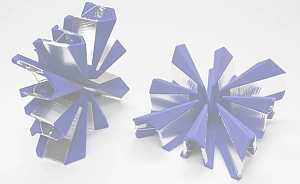Electrostatic Latches
A Binding Designed to Build a Matrix
A simple and robust inter-module latch is possibly the most important component of a modular robotic system. The electrostatic latch pictured below was developed as part of the Carnegie Mellon-Intel Claytronics Research Project. It incorporates many innovative features into a simple, robust device for attaching adjacent modules to each other in a lattice-style robotic system. These features include a parallel plate capacitor constructed from flexible electrodes of aluminum foil and dielectric film to create an adhesion force from electrostatic pressure. Its physical alignment of electrodes also enables the latch to engage a mechanical shear force that strengthens its holding force.

The electrodes that form the latch fit into "genderless " faces constructed as star-shaped plastic frames carried by each module. In the design of the circuits, each electrode functions as one-half of a complete capacitor. A latch forms when the faces of two adjacent modules come together and create an electrostatic field between the flexible electrodes.
Each star-shaped face supports passive self-alignment of the link with a 45-degree blade angle at the top of each comb on the face. The design also supports easy disengagement with a five-degree release angle along the vertical lines of the faces.
The parallel alignment of the electrodes in forming the complete capacitor plate introduces a shear force - or friction - that strengthens the binding of the latch. Once formed, the latch requires almost zero static power to maintain its holding force. Additionally, the presence of multiple circuits among the electrodes provides the latch with simultaneous capacity also to exchange power and communicate data between modules. These features make the device suitable for lattice-style robots in both nanotechnology (micro-scale) and macroscale applications.
In its electrical design, the electrostatic latch uses the closely spaced plates of a parallel capacitor, which generate an electrostatic force to attract each other when the capacitor is charged. After the latch closes, residual charge maintains the latch indefinitely. A thin dielectric film on each conductive plate provides insulation.
Employing capacitive coupling, the latch adheres with a force of 0.6 N/cm 2 while requiring almost zero static power to maintain the force after the latch forms. A specific degree of flexibility in the electrodes maximizes the mutual coupling of electrodes. Electrodes that are too rigid or too flexible do not provide an adequate level of latch performance.
Moreover, the electrodes create multiple circuits, which allow transmission of power and data for communication between modules. This design serves several functions within the robotic module and enables a level of efficiency that reduces requirements for total weight, volume and complexity. This design feature thus yields simpler paths to performance and scaling goals in robotic modules.
The factor that enables electrostatic adhesion to be effective at the macroscale is an interface for the electric field that also creates a shear force from mechanical friction. A combination of electrostatic and shear forces results from the alignment.
Currently, the electrostatic latch is being tested on a modular Cube that is 28 cm on a side.
To gain a close-up view of this hardware and further discussion of its functionality, read these design notes .
Publications and Documents
NOT FOUND: "Electrostatic Latching for Inter-module Adhesion, Power, Transfer and Communication in Modular Robots,
